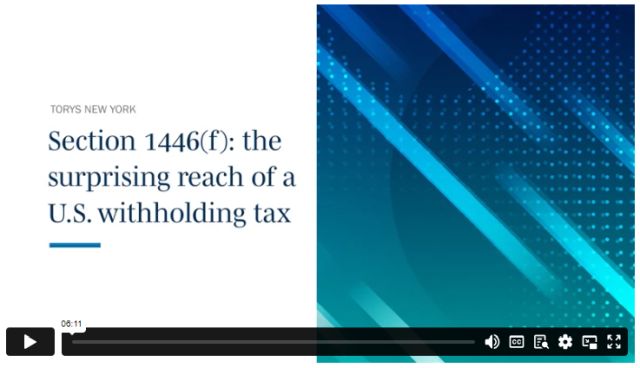Video transcript
Meghan McKeever (00:06): Secondary market dealmaking has been the talk of 2023 as LPs look to rebalance their portfolios and GPs look for ways to unlock liquidity for their investors. Adding to that story for 2023 and beyond is a US withholding tax requirement that has been getting more and more attention from both investors and funds. It was first introduced by the Tax Cuts and Jobs Act in 2017, and this year an additional requirement became effective.
I'm Meghan McKeever and I'm here with my colleague Michelle Lu from Torys' New York office to help you understand this new withholding tax regime.
Michelle Lu (00:41): Thanks, Meghan. The challenge here starts with the fact that many funds are organized as partnerships for US tax purposes. This matters because the 2017 Tax Cuts and Jobs Act made two changes that apply to sales of partnership interests by foreign entities, meaning entities outside the US. One change is a general tax rule, and second is a new withholding requirement.
So, the first change says that when a foreign entity sells a partnership interest, the seller's gain or loss from the sale is treated as active US business income to the extent that the partnership itself is engaged in a US trade or business. Now the US taxes active US business income, so this means if a foreign entity sells an interest in a partnership engaged in a US trade or business, the foreign seller has to file a US tax return and pay US tax on any gain from that sale.
But there's a problem. As I mentioned, this applies when you have a foreign seller. So, Congress was worried that if you have a foreign seller who doesn't pay the US tax on the sale, the IRS may not be able to find the seller because they're outside the US. So, the Tax Cuts and Jobs Act made a second change and added a withholding tax that applies to any sale of a partnership interest by a foreign partner.
This withholding tax was added in what you might have heard people talk about as "Section 1446(f)" of the US tax code. And under that section, a buyer of a partnership interest must withhold 10% of the total sale price, unless the seller or the partnership provides an exemption certificate. And starting January 1st of this year, 2023, if the buyer doesn't withhold that 10%, the partnership being sold must withhold on future partnership distributions to the buyer.
So, this is really an enforcement tool. It means that even if a foreign seller doesn't pay US tax on the sale, the IRS can instead go after the buyer or a partnership which will still have ties to the US as a result of its US business. So that's the tax change. What does this mean for secondary transactions, Meghan?
Meghan McKeever (02:53): Well, this means that any time you buy or sell a partnership interest, you now need to consider this Section 1446(f) withholding requirement. Technically, this withholding requirement applies any time a foreign entity sells any kind of partnership interest anywhere in the world. And in a way that's counterintuitive, right? If a Canadian sells interest in a Canadian partnership that holds only Canadian assets and does business only in Canada, this US withholding tax applies.
The withholding tax also applies to sales to affiliates unless the sale is a non-recognition transfer for US tax purposes. But Michelle, you mentioned the withholding requirement doesn't apply if the seller is a US entity.
Michelle Lu (03:32): That's right. The first question is always, "is a seller a US entity?" If the seller is US and can provide a W-9, then you don't need to worry about this 10% withholding requirement.
Meghan McKeever (03:42): So, what about when the seller is from outside of the US? You also mentioned there's a way to avoid the withholding tax requirement for a foreign seller.
Michelle Lu (03:49): That's right, Meghan. If you have a foreign seller, you don't need to withhold if you can get an exemption certificate. There are a few different kinds of these. The most common one is a certificate that says there's minimal or even no US trade or business in a partnership that's being sold. This kind of certificate can be provided by a seller, which we call "self-certifying", or the certificate can be provided by the general partner of the partnership that's being sold.
One thing that's important to note is that in order for a seller to self-certify, they generally must have received K-1s and they must have held the partnership interest for three full taxable years.
Meghan McKeever (04:27): That three-year requirement sounds like it can be a problem for fund alternative investment vehicles or "AIVs", which often may not have been around yet for three years.
Michelle Lu (04:35): That's right. And so, when that happens, the seller can't self-certify. And instead, then the parties will need the general partner to cooperate and provide a partnership certificate in order to avoid that 10% withholding.
Meghan McKeever (04:47): So that covers sellers. Is there anything else buyers need to keep in mind?
Michelle Lu (04:51): That's a great question! A buyer of a partnership interest is required to provide a certificate as well. This is a certificate provided to the partnership and that says the buyer has complied with this withholding requirement, either because the buyer has withheld that 10%, or because the buyer has received one of these exemption certificates from the seller or the partnership.
Meghan McKeever (05:13): Got it. Okay. So, let's wrap up with a few practice points. If you have a foreign seller of partnership interests, look into the option of an exemption certificate. This way it's possible to avoid the withholding requirement. The seller may be able to self-certify that the partnership doesn't carry out significant trade or business, and if the seller can't self-certify, you'll need the GP to cooperate and provide a partnership certificate.
This can take time, so it needs to be serviced well in advance of closing. Stay alert for withholding requirements in non-secondary transactions. So, section 1446(f) can also come up in transactions other than secondaries. Any time there's an actual or deemed transfer of a partnership interest. So, for example, if the subscription price paid by a new partner is used to redeem existing partners, that can be a disguised sale of partnership interests for US tax purposes.
With increased secondary market dealmaking, buyers and sellers of private equity funds should watch out for a U.S. withholding tax that has additional urgency starting this year. Absent an exemption certificate, both a foreign seller and the buyer will be liable for the 10% withholding tax.
In this video, Meghan McKeever and Michelle Lu from our New York office explain how the tax change came to be and what those in the Canadian private equity space can do to adapt.
You'll learn:
- Why the withholding tax applies only to foreign entities
- How Canadian buyers and sellers of private equity funds can mitigate their tax risk
- How to obtain an exemption certificate to avoid the withholding requirement
- The importance of this change for secondary transactions
The content of this article is intended to provide a general guide to the subject matter. Specialist advice should be sought about your specific circumstances.


